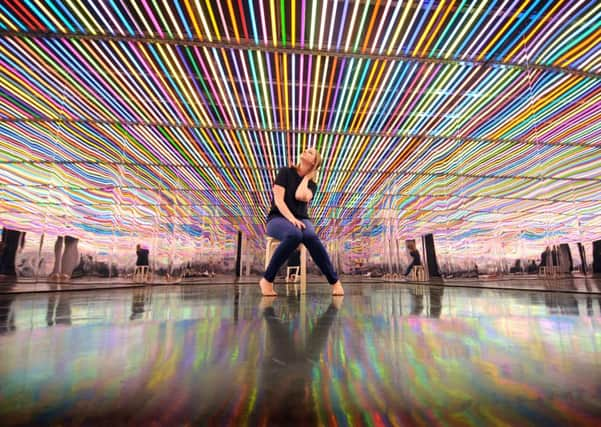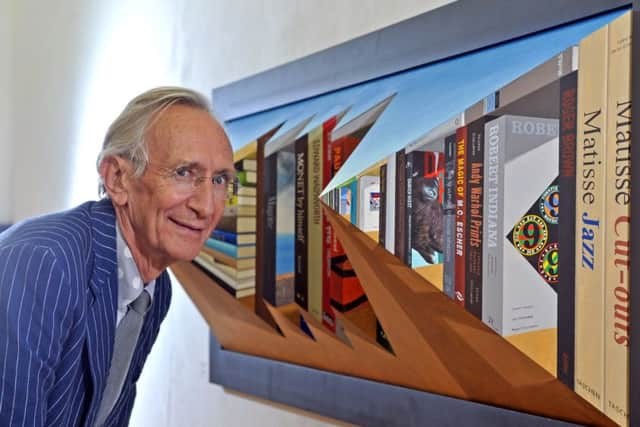Names in the frames: Amazing alumni of Leeds College of Art


Since the college opened in 1846 as the as the Leeds Government School of Art and Design, its various studios have witnessed the early careers of some of Britain’s best-loved artists. During the 1920s it was where Yorkshire sculptors Barbara Hepworth and Henry Moore came to study. Before them, the college had honed the artistic talents of painter Jacob Kramer and pioneer of modernism John Cecil Stephenson, while afterwards came the likes of printmaker Norman Ackroyd, industrial artist Edna Lumb and, for a year in the early 1980s, Damien Hirst.
Surrealist artist Patrick Hughes also gets a mention. He wasn’t a student, but a lecturer and while he was only in post for four years, his time in Leeds made a big impression.
Advertisement
Hide AdAdvertisement
Hide Ad“My association with Leeds began in The Wrens Public House,” says the 77-year-old. “I was having a drink with one of the lecturers, Ricky Atkinson, who asked whether I fancied a job. I was working in Bradford at the time, but I had always really admired how they ran things in Leeds, so I didn’t need to be asked twice.


“There was something very special – in fact there still is – about walking under that mosaic above the entrance to the Vernon Street building and thinking, ‘I am following in the exact footsteps of Henry Moore and Barbara Hepworth’.”
Hughes’ spell at Leeds proved to be creatively important and it was there in 1964 that he had what he calls his ‘lightbulb moment’ which led to the development of his trademark ‘reverspective’ style which gives his paintings a 3D quality.
“I remember exactly the moment it happened. I’d finished a particular painting and when I held it up, I realised that it created a real illusion of movement. I had produced a work which changed depending where the viewer was standing and that was the start of the style for which I became known.”
Advertisement
Hide AdAdvertisement
Hide AdHughes eventually left Leeds for London, where he had spells teaching at both Chelsea School of Art and Goldsmiths, but the city still occupies a special place in his heart and he has recently launched a bursary in the name of his friend and fellow surrealist artist Anthony Earnshaw.


“Tuition fees have changed arts education beyond recognition. I remember talking to one of my friends who lectures at Oxford and he said that if you went back 20 or 30 years the vast majority of art students were working class and from state school. Now it is overwhelming middle class and I can’t say I’m surprised. How do you justify to your parents that it’s a good idea to spend £30,000 studying art when everyone knows how difficult it is to make a living from it.
“It’s very sad and I think we are in danger of losing a lot of our young creative voices. That was one of the reasons I set up the bursary, it is about giving people who might struggle financially a bit of support. I loved my time teaching, it was incredibly rewarding despite the fact that adolescents are like unexploded bombs. There is something incredibly satisfying about being able to pass on a little of your knowledge and make them think in a different way.”
Leeds College of Art has been marking its 170th anniversary with a series of exhibitions of work by past students and the celebrations will culminate later this month with a party at the Leeds City Museum.
Advertisement
Hide AdAdvertisement
Hide Ad“One of the reasons the college has been so successful is because it feels like a real community of artists,” says principal Simone Wonnacott, who joined the college’s human resources department more than 20 years ago. “Every time I walk through the door it’s impossible not feel inspired, although I will confess that my own artistic talents are pretty limited.”
While the college is keen to preserve its intimate atmosphere, a major expansion of its Blenheim Walk site is already under way, it is going through the process to gain full university accreditation and it is about to launch two new degrees in pop music and filmmaking.
“So many of our courses overlap,” says Simone. “The graphic design students often collaborate with our fashion and photography departments and these two new courses seemed like a natural fit. We have already appointed the course leader for pop music and even before the first timetable has even been launched he has been inundated with people wanting to chat about possible projects.”
Leeds College of Art has always had philosophy to make its courses as accessible as possible.
Advertisement
Hide AdAdvertisement
Hide AdOne of its current students is Kimberley Burrows who is almost completely blind after being born two months premature. Despite being severely visually impaired, Kimberley has always been artistic and she is currently in her first year of BA (Hons) Illustration.
“I did look at a number of other colleges, but I knew instantly that this was the place for me. One of the tutors has two daughters who are visually impaired and right from my very first meeting they bent over backwards to make sure the course could work for me.”
Kimberley says she comes into college seven days a week and while it takes her much longer than some of the other students to complete projects, she remains determined to realise her wish of becoming a full-time children’s book illustrator.
“Up until the age of 17, I spent a lot of time in Great Ormond Street Hospital and art was a way of keeping busy,” says Kimberley, who was named the RNIB Young Illustrator of the Year in 2014. “Over the years I have developed various techniques to ensure that I don’t colour outside the lines and while it is time-consuming, I absolutely love it.
Advertisement
Hide AdAdvertisement
Hide Ad“When I was little there were no real role models for someone like me and I would like to think that my work will make a difference. I want to show people that despite having a disability you can still achieve your dreams.”
When they come to refresh that timeline in a few years it may be that Kimberley joins the ranks of Leeds College of Art’s most famous alumni.